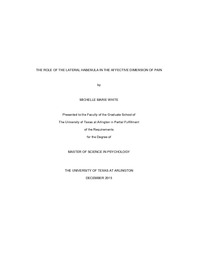| dc.description.abstract | The lateral habenula (LHb) functions as a hub that integrates information from cortical regions to aid in emotional decision-making, as well as helping to create response strategies under stress (Hikosaka, 2010; Proulx, Hikosaka, & Malinow, 2014; Thorton, Bradbury, & Davies, 1990; Evans & Thorton, 1984; Thorton & Evans, 1984; Thorton & Evans, 1982; Thorton, Evans, & Harris, 1985). In addition, the LHb functions in a descending pain modulatory circuit involving both the nucleus accumbens and periacqueductal gray (Shelton, Becerra, & Borsook, 2012). These two functions of the LHb indicate its importance in decision-making during heightened states of arousal, such as pain. The pupose of the current study was to assess neuronal activation in the LHb during a test of pain affect in addition to sensory testing. Specifically, the hypothesis was tested that cells of the LHb become activated during the Place Escape/Avoidance Paradigm, a test of pain affect in which animals must decide to avoid or withstand painful stimuli. While the assertion has been made that the LHb is involved in the affective component of pain, this claim has not been directly tested. To test the current hypothesis of the LHb’s contribution to the affective dimension of pain, animals received injections of one of three solutions (saline, 0.5% or 2% carrageenan) to the left hindpaw, and then underwent either MPWT testing, PEAP testing, a combination of both, or simply no testing at all. For MPWT testing, animals injected with 2% carrageenan had significantly lower threshold values compared to 0.5% carrageenan (p < .001) and controls (p < .001), which indicated that the experimental conditions were effective. During the PEAP test, animals in pain were expected to first escape and avoid an area that they normally prefer, and indeed, behavioral results supported this notion. Animals in both inflammatory groups did avoid stimulation and spent significantly more time in the light side of the chamber compared to controls for most of the duration of the test (both ps < .05). Additionally, cells of the LHb were examined to assess whether there were higher levels of neuronal activation as measured by c-Fos protein expression. Results indicated that animals injected with 2% carrageenan had significantly higher levels of c-Fos expression in the LHb compared to both 0.5% carrageenan (p < .001) and saline controls (p < .001). To further examine the hypothesis that the LHb contributes to pain affect, the relationship between levels of c-Fos expression and PEAP scores were examined. There was not a significant relationship between these two variables (p = n.s.). Interestingly, there was a significant relationship between c-Fos expression and MPWT scores (p = .013). This could indicate that the lion’s share of work done by the LHb in regards to pain processing is dedicated to mediating sensory information and not information related to pain affect. This research holds importance because it offers further insight into the mechanisms underlying the pain experience. | |


